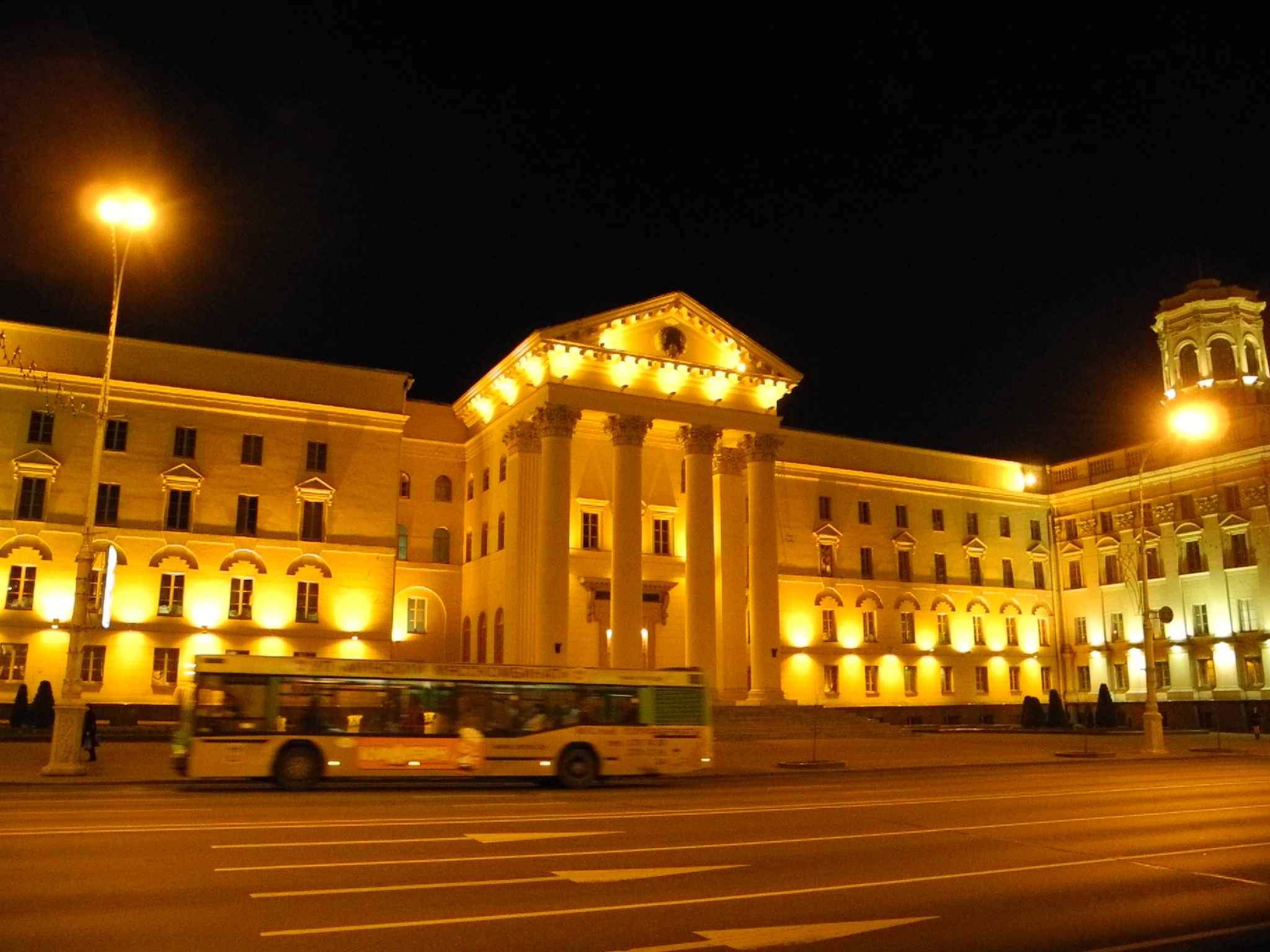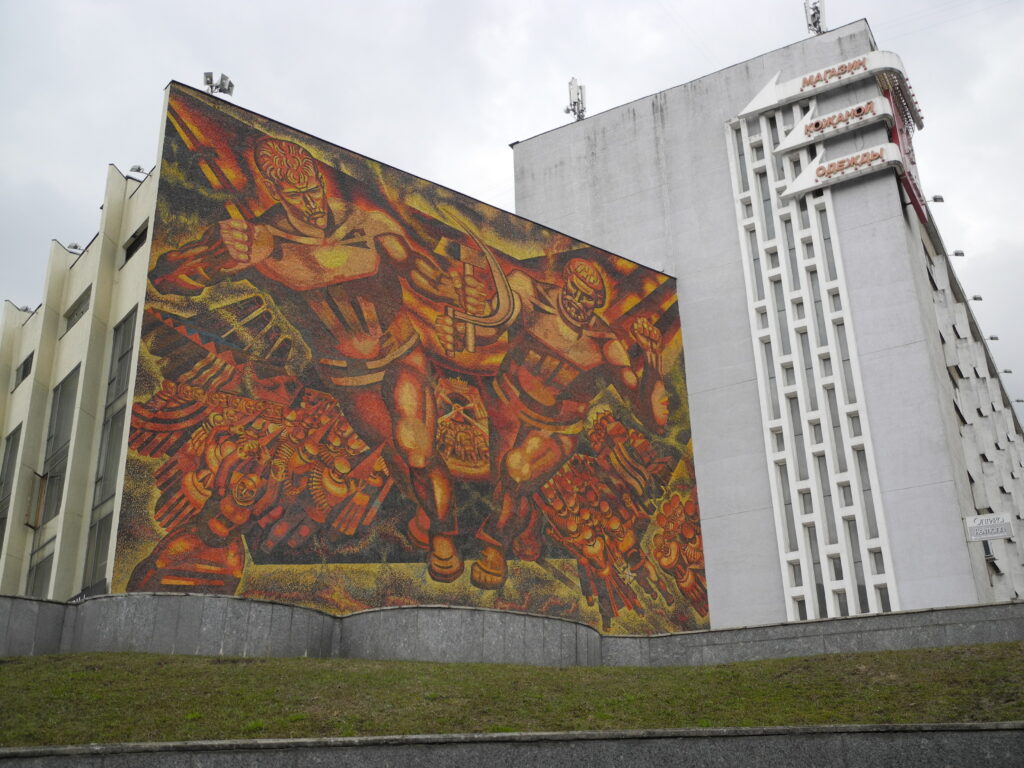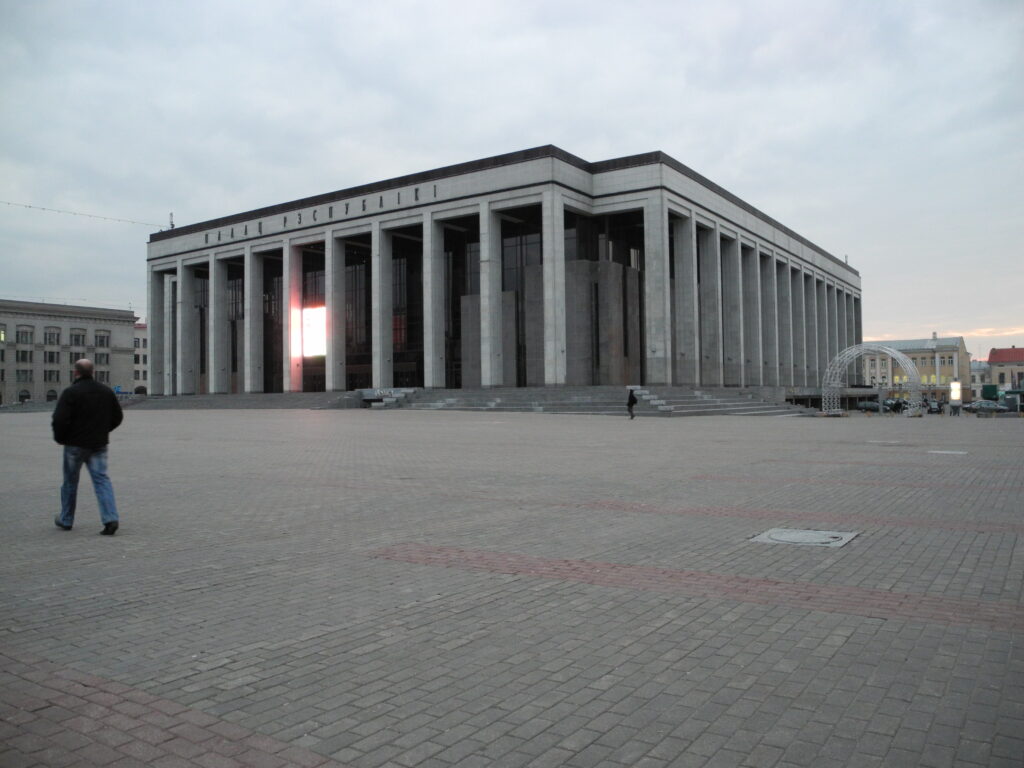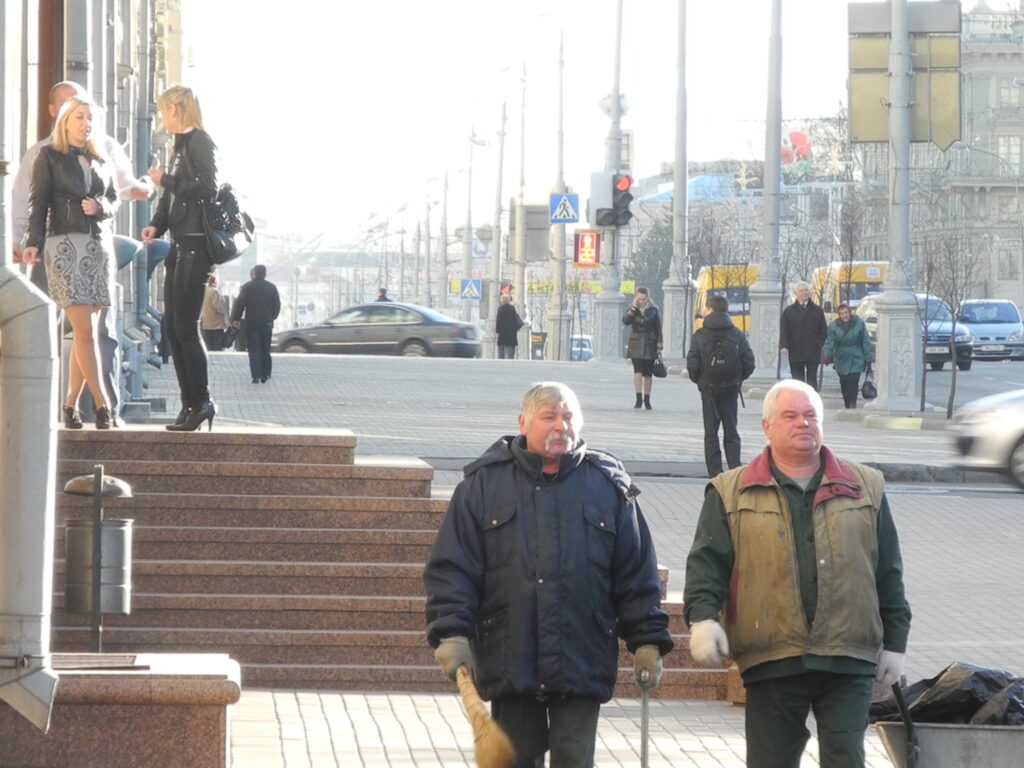Minsk, Lukashenko and the papier-mâché stage

The Minsk of Stalin and Lukashenko, the fictional scenario of a sunny city behind which the misery of real socialism is hidden. A walk with the writer Artur Klinau in the central avenue of the Belarusian capital in a reportage published in 2018 by the monthly "O Magazine" to understand the tensions of these days
The future does not live here, indeed it is almost a miracle that someone lives in these apartments. The external walls are blackened by smog, the plaster is peeling, greenish damp spots dripping around the gutters, electric wires run externally along the walls, drawing dangerous cobwebs. Three ladies bundled up in heavy woolen coats enter the palace through a sturdy iron door, similar to those in bank coffers. It begins to get dark but no windows are lit, the only dim glow comes from the glass that dot the stairwell. Yet, until a second before, the majesty of the façade of the same buildings on the side of the main avenue let us imagine luxurious and privileged lives: until, slipping into a gap between the buildings, we abandoned the artificial scenario of the official facade and we sneaked in to peek what was hiding behind the scenes.
We are in Minsk, on the Praspyekt Nyezalyezhnastsi, the Independence Avenue, the endless axis that cuts through the center of the Belarusian capital, eight kilometers of realsocialist architecture through the places of representation and power of what the press called until recently. the last dictatorship of Europe. Now the term has become inflated, and mixed with populism there are those who use it to confusedly describe the many regimes fleeing from classical representative democracies. The Praspyekt is the avenue that draws the monumental and solemn scenography of the city of the sun, plastically representing the magnificent and progressive destinies of the communist utopia. Whose time here seems not to be up yet.

“There are several avenues like this in various Eastern European cities, a legacy of the Soviet Union: in East Berlin, in Warsaw, Kiev, St. Petersburg and of course in Moscow. But nowhere has its realization been so perfectly successful as in Minsk ”. Speaking is the writer Artur Klinau, our Virgil on his way to discover the city of the sun. A dip in the past, more than a journey into the future, but it is a past that resists here, it has always resisted even when the events of the transition from communism to capitalism, from totalitarianism to liberal democracy unfolded in the rest of Central and Eastern Europe. It is also a past that today arouses a strange suggestion, in a continent that seems to have consumed the euphoria of collapsed walls.
Born in 1965, Artur Klinau is a non-organic intellectual. At one time he would have said he was a dissident from the regime of Aleksandr Lukasenko, the man who has led the country with an iron fist since 1994. But the strange Belarusian dictatorship grants oases of artistic disobedience that were unimaginable in the states of Eastern Europe at the time of ' USSR. Provided, however, that these oases do not turn into political opposition. And Klinau is one of these disobedient intellectuals: he cut his teeth at university on architectural texts, then became famous as a visual artist. He gave birth to a magazine called "pARTisan" and to the Galeria Y exhibition center, which has become the reference point of the non-aligned art scene in Minsk: here exhibitions are set up, books are presented and art and politics are discussed smoky up to late night in the sophisticated and welcoming adjacent café. And since Klinau likes to tell stories, in 2006 he began his career as a writer, publishing the book "City of the sun of dreams" (in German "Sonnenstadt der Träume") in Russian and with the help of the German publishing house Suhrkamp. : a historical-architectural guide able to tell the Belarus of the Lukasenko era through Stalin's urban illusion and Tommaso Campanella's litmus test of utopia.

"Even in Moscow a good part of the ancient city has been preserved", Klinau resumes, pouring a wodka correction into a cup of take-away coffee, while the words turn to steam and try to warm a cold and sunny spring morning , “But here in Minsk the war had not spared much and so it was possible to give life to an organic project born right in the body of the war”. From that pile of rubble, the idea of raising the perfect city, with its sunny boulevard in the center and a large diagonal that cuts through Minsk from west to east: "In the east the sun rises, in the east there is Moscow, towards east we set out for the city of the sun ”.
The starting point is represented by the two towers eleven floors high and developed vertically like a wedding cake, called city gates, which announce the entrance to the ideal city. They stand like two towering sentries in front of the train station, which was still red brick until 1990 and has now been expanded and made nondescript with glass and steel roofs. "The first stop is in the square that I call of wisdom, surrounded by the buildings of power and science", continues Klinau, "there are two universities, the seat of the government, that of the municipality and the post office". There is also a large statue of Lenin who frowns from the top of the pedestal: "And in fact this was called Lenin Square", adds Klinau, "and today it has officially taken the same name as the avenue that crosses it, Piazza dell ' Independence".
The writer stops and thinks aloud: “I was born in the city of the sun, here in fact two cities existed, that of the society of happiness, in which we all believed, and the city proper. The first dissolved over time, the second survived as a monument to ambition towards the unachievable, like a grandiose script for a romantic and sublime play entitled Happiness ”. The naked power of granite masked by the scaffolding of the dream that everyone had to believe: “Wasn't the communist idea the project for the realization of collective happiness? Has humanity ever been able to formulate a more beautiful doctrine? Equality, brotherhood, justice. A society of common harmony, each according to his abilities, to each according to his needs, Heaven on earth, a place that doesn't exist. The utopia. "
The utopia is over, the power has remained. From Stalin to Lukashenko it was a long step but no one stumbled: decades have passed, and the Soviet Republic of Belarus has experienced all the steps of Moscow history, from Khrushchev to Brezhnev, from Andropov to Gorbachev, before obtaining a Finnish independence and take refuge, terrified of the new, in the arms of the new tyrant. The fable of the city of the sun is a perfect parable to try to decrypt the Belarus of the 21st century, this kingdom of Lukashenko that does not seem hermetically sealed to external influences as it did in the regimes of Eastern Europe at the time of the communist bloc.

The first impression that Minsk transmits is that of having ended up under a glass bell. The streets, wide and spacious, are crisscrossed by orderly and low noise traffic. On the sidewalks of the central streets, the few pedestrians are dispersed in the endless spaces, carefully avoiding to attract attention. Life goes on without too much joy, mogia, introverted.
But there is something that does not correspond to the expected cliché. You expect life to go by in black and white, with poor people, bumpy streets, cheap goods in shops, empty groceries and gray high-rises. On the other hand, the bus that takes you from the airport to the city crosses well-kept suburbs, modern and colorful buildings, wide and well tarred streets on which modern, western, medium and large-engined cars run. The shops offer quality goods, in the grocery you can buy everything, even exotic fruit. And the clothing, even without excesses of elegance, shows a certain refinement. The casual style of young people, in particular, you would not distinguish it from that of peers in Berlin, Warsaw or Stockholm. A surprise. It is one side of the coin of the so-called “Lukashenko-system”, the product of the welfare state built over the years by the dictator, which has guaranteed a modest but sure well-being for all in exchange for a free hand in public affairs. The other side is that of political repression.
But it is on the first point that we must insist to understand the secret of the tyrant's long life, beyond repression. "Lukashenko had a good game in emphasizing the negative effects of economic reforms in Russia and Ukraine," explains Valery Karbalewitch, one of the most authoritative Belarusian political scientists and author of a voluminous biography on Lukashenko published in Russia, sitting in a room of the Minsk Historical Museum and sold under the counter in the alternative circles of Minsk, "and to convince its citizens that the social model adopted at home has avoided social differences and the enrichment of the oligarchs". The economy has suffered equally but Lukashenko has managed to survive all the crises by shamelessly drawing on every possible reserve: his model has held up sooner thanks to the resale (especially to the Dutch) of Russian gas purchased from Moscow at low prices, then to the credits received from the European Union, both when at the beginning of this decade it seemed that the dictator wanted to loosen the authoritarian grip, and when he proposed himself as mediator between Moscow and Kiev in the Ukrainian conflict. "The hope for a democratic process was however a pure illusion", adds Karbalewitch, "Lukashenko is a charismatic man and so far he has been able to guess the feelings of the deep belly of the country, but at the same time he is marked by a violent and dominant. He does not think that one day someone will be able to replace him and he cannot imagine a life without power. To keep it he will do everything ”.
As shown by the heavy hand used by the regime every time that dissent moves from the territory of art to that of politics. On the other hand, walking back on the Praspyekt Nyezalyezhnastsi, another bronze statue and another building remind us of the rules in the city of the sun. The statue depicts Feliks Dzerzinskij, the founder of the Cheka, the Soviet secret police ancestor of the KGB; the building that dominates on the opposite side is the headquarters of the KGB, the Belarusian security service and the only one, together with those of puppet states such as Transnistria and South Ossetia, to have kept the name of the original service Soviet. "From here you can only see the facade, you can hardly guess that the building continues behind it for many blocks", concludes Klinau, "there is also a tunnel, which leads directly to the prison: those who do not believe in utopia, enter this palace disappears underground, and is expelled from the city of the sun ”.
We instead go out regularly on the opposite side of the Praspyekt, after passing the red stars illuminated at night and the military bronzes that celebrate the victory of the Soviets over the Nazis in the Second World War (which here is called the Great Patriotic War) that adorn the Piazza della Vittoria. And we slip into less sumptuous streets, almost alleys, where the houses become lower and modest. A few blocks ahead is the Klinau-sponsored art center, in the process of being moved south of downtown. Seated at café Y, Vola (for security reasons we omit the surname) tells the cultural opposition battle of her online magazine called “Generation.by” (and which in the past cost her a few months in prison): “Generation. by is aimed primarily at young people and deals with trends, culture, styles, education ”, he explains. It is an almost apolitical dissent, perhaps naive, which pushes not to have too many illusions about short-term changes, even if something in society is moving, as evidenced by the explosion of Airbnb accommodation for tourists right in the buildings of the city of the sun.
"The original group of Generation.by comes from student experiences, it is made up of people born in the Soviet Union who then lived the short Belarusian spring in the first half of the nineties", explains Vola, "the younger generation, however, it is less ideological and more practical, it has found computers and the Internet and tries to exploit their full potential for freedom. We offer them the full range of multimedia production, articles but above all blogs, videos, images. The satirical cartoons and travel stories abroad are very successful ”. It is probably the only dissent currently possible: those who go to the square find police batons, those who frequent the world that revolves around the artistic circle Y carve out their own space of aesthetic resistance, a refuge in the city of the sun, within which live, as Vaclav Havel said, out of the lie, in the truth.
This is a machine translation from Italian language of a post published on Start Magazine at the URL https://www.startmag.it/mondo/nella-minsk-di-lukashenko-il-palcoscenico-di-cartapesta-che-rischia-di-crollare/ on Sun, 16 Aug 2020 05:20:50 +0000.
